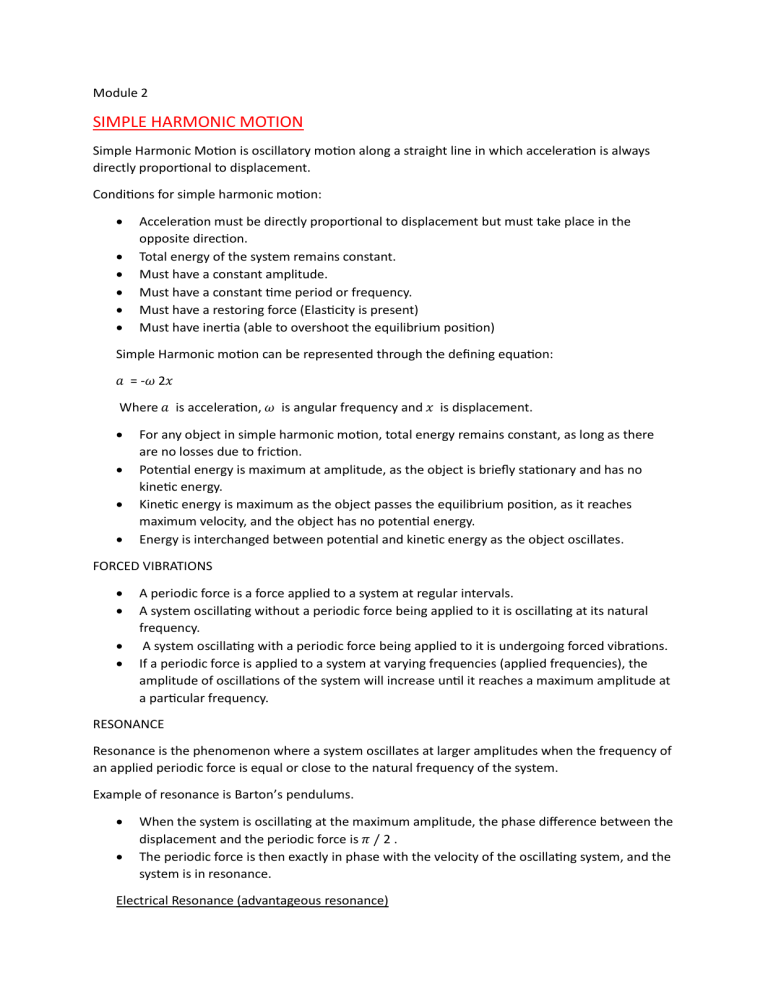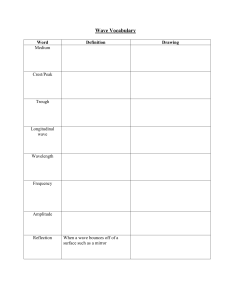
Module 2 SIMPLE HARMONIC MOTION Simple Harmonic Motion is oscillatory motion along a straight line in which acceleration is always directly proportional to displacement. Conditions for simple harmonic motion: Acceleration must be directly proportional to displacement but must take place in the opposite direction. Total energy of the system remains constant. Must have a constant amplitude. Must have a constant time period or frequency. Must have a restoring force (Elasticity is present) Must have inertia (able to overshoot the equilibrium position) Simple Harmonic motion can be represented through the defining equation: 𝑎� = -𝜔�2𝑥�� Where 𝑎� is acceleration, 𝜔� is angular frequency and 𝑥� is displacement. For any object in simple harmonic motion, total energy remains constant, as long as there are no losses due to friction. Potential energy is maximum at amplitude, as the object is briefly stationary and has no kinetic energy. Kinetic energy is maximum as the object passes the equilibrium position, as it reaches maximum velocity, and the object has no potential energy. Energy is interchanged between potential and kinetic energy as the object oscillates. FORCED VIBRATIONS A periodic force is a force applied to a system at regular intervals. A system oscillating without a periodic force being applied to it is oscillating at its natural frequency. A system oscillating with a periodic force being applied to it is undergoing forced vibrations. If a periodic force is applied to a system at varying frequencies (applied frequencies), the amplitude of oscillations of the system will increase until it reaches a maximum amplitude at a particular frequency. RESONANCE Resonance is the phenomenon where a system oscillates at larger amplitudes when the frequency of an applied periodic force is equal or close to the natural frequency of the system. Example of resonance is Barton’s pendulums. When the system is oscillating at the maximum amplitude, the phase difference between the displacement and the periodic force is 𝜋�/ 2 . The periodic force is then exactly in phase with the velocity of the oscillating system, and the system is in resonance. Electrical Resonance (advantageous resonance) Resonance is used to tune radios and televisions. Magnetic Resonance Imaging (advantageous resonance) Resonance is used in medical diagnostic imaging of the body. DAMPING Damping is the decrease in amplitude of an oscillating system over time due to loss of energy. 3 types of damping: under-damping, critical damping, and over-damping 1. Under-Damping: the amplitude of the object decreases over time, with the object making several oscillations before coming to rest. 2. Critical Damping: the oscillating object reaches the equilibrium position in the shortest possible time and remains there without passing through it. 3. Over Damping: the object does not oscillate at all, and instead very slowly reaches the equilibrium position because the energy loss is so great. WAVES A wave is a travelling disturbance that propagates through a medium, transporting energy from one location (its source) to another location, without transporting matter. Wave Parameters Displacement- the distance and direction of a vibrating particle from its equilibrium position Amplitude- the maximum displacement of a vibrating particle from the equilibrium position, or the height of a wave crest/depth of a wave trough from the equilibrium position. Wavelength- the distance between two consecutive points on a wave in phase, or between two successive crests or troughs. Period- the time taken for a particle on the wave to complete one complete oscillation, or the time taken for the crest of a wave to move forward one wavelength. Frequency- this is the number of crests passing a given point per second. 𝑓� = 1/ 𝑇��where�T�is�period Velocity (Wave Speed)- the distance by the wave travelled per unit time. Equation: Phase- the fraction of an oscillation completed by a particle on a wave since the start of the cycle. o Phase difference is the fraction of a cycle between two particles vibrating at the same frequency along a wave. Transverse and Longitudinal Waves A transverse wave is a wave in which oscillations occur at right angles to the direction of travel of the wave. o Waves are made up of crests and troughs o Transverse waves can be polarized A longitudinal wave is a wave in which oscillations occur along the line of travel of the wave. o Waves are made up of compressions and rarefactions o Longitudinal waves cannot be polarized Polarization • Polarization is the restriction of transverse waves to one plane of vibration. • Unpolarized waves change from one plane to another. • Ordinary light waves are unpolarised or polarised in all planes. • A polaroid sheet can be used to polarize light; it behaves like a set of slits which only allow light in one plane to pass through. Progressive and Stationary Waves • Progressive Waves or travelling waves transfer energy from one point to another. They propagate through the medium. • Stationary waves (or standing waves) do not transfer energy, instead energy is confined. They occur when a progressive wave is being reflected back and forth in a small region of space. Behaviour of Waves 1. Rectilinear Propagation- in a homogenous medium, a wave travels at a constant speed in a straight line. 2. Reflection- Occurs when a wave changes direction at a boundary between two media, remaining in the original medium. Laws of Reflection states that: a. When waves are reflected off a plane surface, the angle of incidence is equal to the angle of reflection. b. The angle of incidence, normal and angle of reflection all lie in the same plane. 3. Refraction- This is the change in direction of a wave as it crosses a boundary between two media and undergoes a change in speed. Laws of Refraction states that: a. The angle of incidence, normal and angle of refraction all lie in the same plane. b. The ratio of sine of the angle of incidence to the sine of the angle of refraction is a constant (Snell’s Law). The refractive index, n, of a material is defined as the ratio of the speed of light in free space to the speed of light in the material. In equation form, this is given by The critical angle is the angle of incidence for which the angle of refraction is 90°: • Diffraction is the phenomenon in which a wave spreads out in various directions when passing through a gap of a similar magnitude to its wavelength • Interference describes the interaction between two waves in the same location, that is, superposition of two waves of the same type. The Ear Sound describes travelling longitudinal waves passing through a material medium like air. Pitch is related to the frequency of a sound and is perceived as the highness or lowness/depth of a sound. Sound frequencies make up a spectrum with three major sections: a. Audible Sound- Sound between 20 Hz and 20,000 Hz, which is detectable generally by the human ear. b. Infrasound- Sound less than 20Hz c. Ultrasound- Sound greater than 20,000 Hz The Eye A lens is a transparent material which has at least one curved surface. Important definitions for lenses: The Optical Centre is the physical centre of the lens. The principal axis is the line passing through the optical centre of the lens and is perpendicular to both of its surfaces. The principal focus is the point on the principal axis where rays parallel and close to the principal axis converge or appear to converge. The focal length (f) is the distance between the optical centre and the principal focus. The focal plane is the plane passing through the principal focus. This is the plane upon which all light rays parallel to each other (don’t have to be parallel to the principal axis) converge on this plane.






